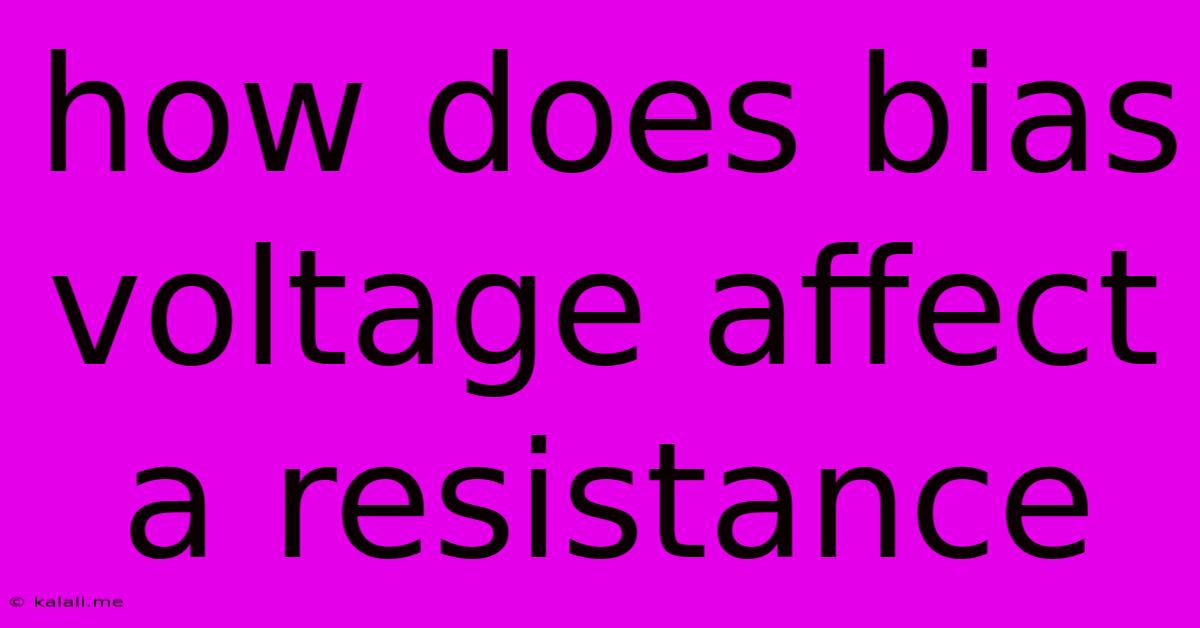How Does Bias Voltage Affect A Resistance
Kalali
May 24, 2025 · 3 min read

Table of Contents
How Does Bias Voltage Affect Resistance? A Deep Dive into Non-Linear Resistors
The relationship between voltage and current in a resistor is fundamental to electronics. Ohm's Law, V = IR, elegantly describes this relationship for ideal resistors, implying a constant resistance regardless of the applied voltage. However, real-world components often deviate from this ideal behavior. This article explores how bias voltage influences resistance in various types of resistors, highlighting the non-linear nature of many practical devices. Understanding this impact is crucial for accurate circuit design and analysis.
Ohm's Law and the Ideal Resistor
Before delving into the complexities of non-linear behavior, let's revisit Ohm's Law. It states that the current (I) flowing through a resistor is directly proportional to the voltage (V) applied across it, with the constant of proportionality being the resistance (R). This implies a linear relationship—a straight line when plotting current against voltage. For an ideal resistor, R remains constant irrespective of the applied voltage or current.
Non-Linear Resistors: Where the Bias Voltage Matters
Many common electronic components exhibit non-linear resistance, meaning their resistance changes significantly with the applied bias voltage. This variation stems from several factors including material properties, temperature dependencies, and device construction. Let's examine some key examples:
-
Thermistors: These resistors exhibit a strong temperature dependence. An increase in bias voltage leads to increased power dissipation (P = IV = V²/R), resulting in a temperature rise. As temperature changes, the resistance changes accordingly; positive temperature coefficient (PTC) thermistors increase resistance with temperature, while negative temperature coefficient (NTC) thermistors decrease resistance with temperature. Therefore, the bias voltage indirectly influences resistance through its effect on temperature.
-
Varistors (Metal Oxide Varistors - MOVs): These are voltage-dependent resistors. Their resistance is significantly lower at higher voltages and substantially higher at lower voltages. This characteristic is especially useful in surge protection applications. The bias voltage directly determines the varistor's resistance, leading to a highly non-linear response.
-
Light-Dependent Resistors (LDRs): The resistance of an LDR changes dramatically depending on the incident light intensity. While not directly influenced by bias voltage in the same way as thermistors or varistors, the power dissipation from the bias voltage can slightly influence temperature, indirectly affecting the LDR's resistance. Ambient light conditions, however, are the dominant factor.
-
Semiconductor Diodes: Although not strictly resistors, diodes exhibit a highly non-linear current-voltage characteristic. The resistance is extremely high in the reverse bias condition and decreases significantly in the forward bias condition. The bias voltage dramatically alters the effective resistance of a diode.
Understanding the Impact: Practical Implications
The impact of bias voltage on resistance is not merely a theoretical curiosity. It has crucial implications for circuit design and performance:
-
Power Dissipation: In non-linear resistors, power dissipation changes non-linearly with voltage. Accurate power calculations require considering the voltage-dependent resistance.
-
Circuit Stability: Changes in resistance due to voltage can destabilize circuits, leading to oscillations or unexpected behavior.
-
Signal Distortion: In signal processing applications, non-linear resistance can introduce distortion as the resistance varies with the signal amplitude.
-
Circuit Modeling: Accurate circuit simulation requires incorporating the non-linear resistance characteristics of the components.
Conclusion
While Ohm's Law provides a valuable simplification for ideal resistors, real-world components often exhibit non-linear behavior. Understanding how bias voltage affects resistance in different types of resistors, such as thermistors, varistors, and LDRs, is critical for designing and analyzing reliable and accurate electronic circuits. Considering these non-linearities ensures that designs function as intended, particularly in applications involving significant power dissipation or sensitive signal processing.
Latest Posts
Latest Posts
-
Free Software To Recognize Peaks In A Chromatogram
May 24, 2025
-
How To Remove Mold From Shower Caulking
May 24, 2025
-
Quote The Whole Is Greater Than The Sum
May 24, 2025
-
How To Reply To Two Knights Defence Italian Game
May 24, 2025
-
Is Density An Extensive Or Intensive Property
May 24, 2025
Related Post
Thank you for visiting our website which covers about How Does Bias Voltage Affect A Resistance . We hope the information provided has been useful to you. Feel free to contact us if you have any questions or need further assistance. See you next time and don't miss to bookmark.